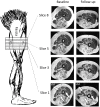Distinct disease phases in muscles of facioscapulohumeral dystrophy patients identified by MR detected fat infiltration
- PMID: 24454861
- PMCID: PMC3891814
- DOI: 10.1371/journal.pone.0085416
Distinct disease phases in muscles of facioscapulohumeral dystrophy patients identified by MR detected fat infiltration
Abstract
Facioscapulohumeral muscular dystrophy (FSHD) is an untreatable disease, characterized by asymmetric progressive weakness of skeletal muscle with fatty infiltration. Although the main genetic defect has been uncovered, the downstream mechanisms causing FSHD are not understood. The objective of this study was to determine natural disease state and progression in muscles of FSHD patients and to establish diagnostic biomarkers by quantitative MRI of fat infiltration and phosphorylated metabolites. MRI was performed at 3T with dedicated coils on legs of 41 patients (28 men/13 women, age 34-76 years), of which eleven were re-examined after four months of usual care. Muscular fat fraction was determined with multi spin-echo and T1 weighted MRI, edema by TIRM and phosphorylated metabolites by 3D (31)P MR spectroscopic imaging. Fat fractions were compared to clinical severity, muscle force, age, edema and phosphocreatine (PCr)/ATP. Longitudinal intramuscular fat fraction variation was analyzed by linear regression. Increased intramuscular fat correlated with age (p<0.05), FSHD severity score (p<0.0001), inversely with muscle strength (p<0.0001), and also occurred sub-clinically. Muscles were nearly dichotomously divided in those with high and with low fat fraction, with only 13% having an intermediate fat fraction. The intramuscular fat fraction along the muscle's length, increased from proximal to distal. This fat gradient was the steepest for intermediate fat infiltrated muscles (0.07±0.01/cm, p<0.001). Leg muscles in this intermediate phase showed a decreased PCr/ATP (p<0.05) and the fastest increase in fatty infiltration over time (0.18±0.15/year, p<0.001), which correlated with initial edema (p<0.01), if present. Thus, in the MR assessment of fat infiltration as biomarker for diseased muscles, the intramuscular fat distribution needs to be taken into account. Our results indicate that healthy individual leg muscles become diseased by entering a progressive phase with distal fat infiltration and altered energy metabolite levels. Fat replacement then relatively rapidly spreads over the whole muscle.
Conflict of interest statement
Figures






Similar articles
-
Muscle MRI findings in facioscapulohumeral muscular dystrophy.Eur Radiol. 2016 Mar;26(3):693-705. doi: 10.1007/s00330-015-3890-1. Epub 2015 Jun 27. Eur Radiol. 2016. PMID: 26115655
-
Only fat infiltrated muscles in resting lower leg of FSHD patients show disturbed energy metabolism.NMR Biomed. 2010 Jul;23(6):563-8. doi: 10.1002/nbm.1494. NMR Biomed. 2010. PMID: 20175146
-
Quantitative MR imaging of individual muscle involvement in facioscapulohumeral muscular dystrophy.Neuromuscul Disord. 2009 May;19(5):357-62. doi: 10.1016/j.nmd.2009.02.009. Epub 2009 Mar 28. Neuromuscul Disord. 2009. PMID: 19329315
-
What's in a name? The clinical features of facioscapulohumeral muscular dystrophy.Pract Neurol. 2016 Jun;16(3):201-7. doi: 10.1136/practneurol-2015-001353. Epub 2016 Feb 9. Pract Neurol. 2016. PMID: 26862222 Review.
-
Muscle MRI of facioscapulohumeral dystrophy (FSHD): A growing demand and a promising approach.Rev Neurol (Paris). 2016 Oct;172(10):566-571. doi: 10.1016/j.neurol.2016.08.002. Epub 2016 Sep 20. Rev Neurol (Paris). 2016. PMID: 27663058 Review.
Cited by
-
Muscle MRI findings in facioscapulohumeral muscular dystrophy.Eur Radiol. 2016 Mar;26(3):693-705. doi: 10.1007/s00330-015-3890-1. Epub 2015 Jun 27. Eur Radiol. 2016. PMID: 26115655
-
Quantification of disease progression in spinal muscular atrophy with muscle MRI-a pilot study.NMR Biomed. 2021 Apr;34(4):e4473. doi: 10.1002/nbm.4473. Epub 2021 Jan 22. NMR Biomed. 2021. PMID: 33480130 Free PMC article.
-
Multi-scale machine learning model predicts muscle and functional disease progression.Sci Rep. 2025 Jul 16;15(1):25339. doi: 10.1038/s41598-025-09516-8. Sci Rep. 2025. PMID: 40670422 Free PMC article.
-
Facioscapulohumeral muscular dystrophy: genetics, gene activation and downstream signalling with regard to recent therapeutic approaches: an update.Orphanet J Rare Dis. 2021 Mar 12;16(1):129. doi: 10.1186/s13023-021-01760-1. Orphanet J Rare Dis. 2021. PMID: 33712050 Free PMC article. Review.
-
Muscle Quantitative MR Imaging and Clustering Analysis in Patients with Facioscapulohumeral Muscular Dystrophy Type 1.PLoS One. 2015 Jul 16;10(7):e0132717. doi: 10.1371/journal.pone.0132717. eCollection 2015. PLoS One. 2015. PMID: 26181385 Free PMC article.
References
-
- Padberg GW (1982) Facioscapulohumeral Disease. Leiden, The Netherlands: University of Leiden Thesis.
-
- Pandya S, King WM, Tawil R (2008) Facioscapulohumeral dystrophy. Phys Ther 88: 105–113. - PubMed
Publication types
MeSH terms
Substances
LinkOut - more resources
Full Text Sources
Other Literature Sources
Medical

